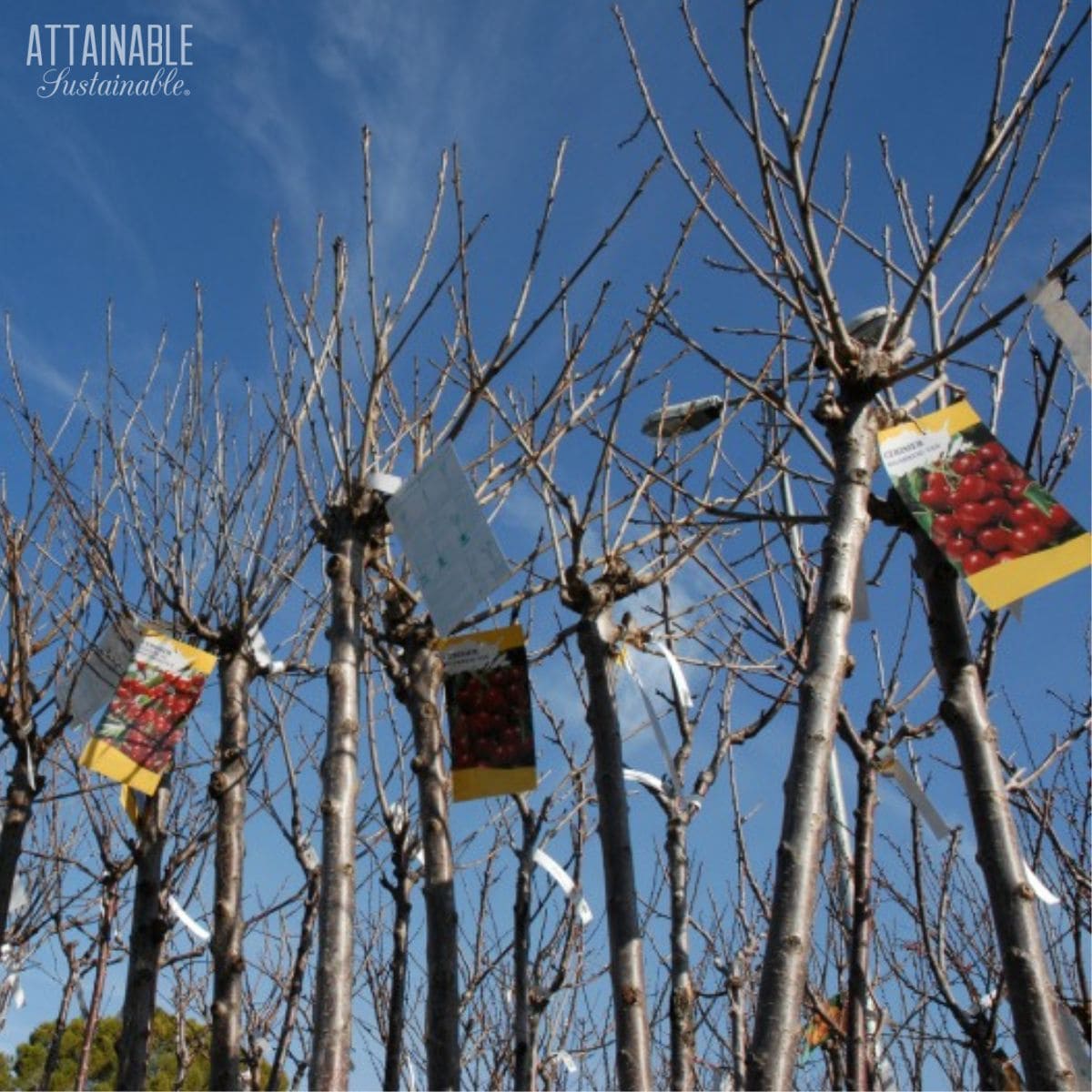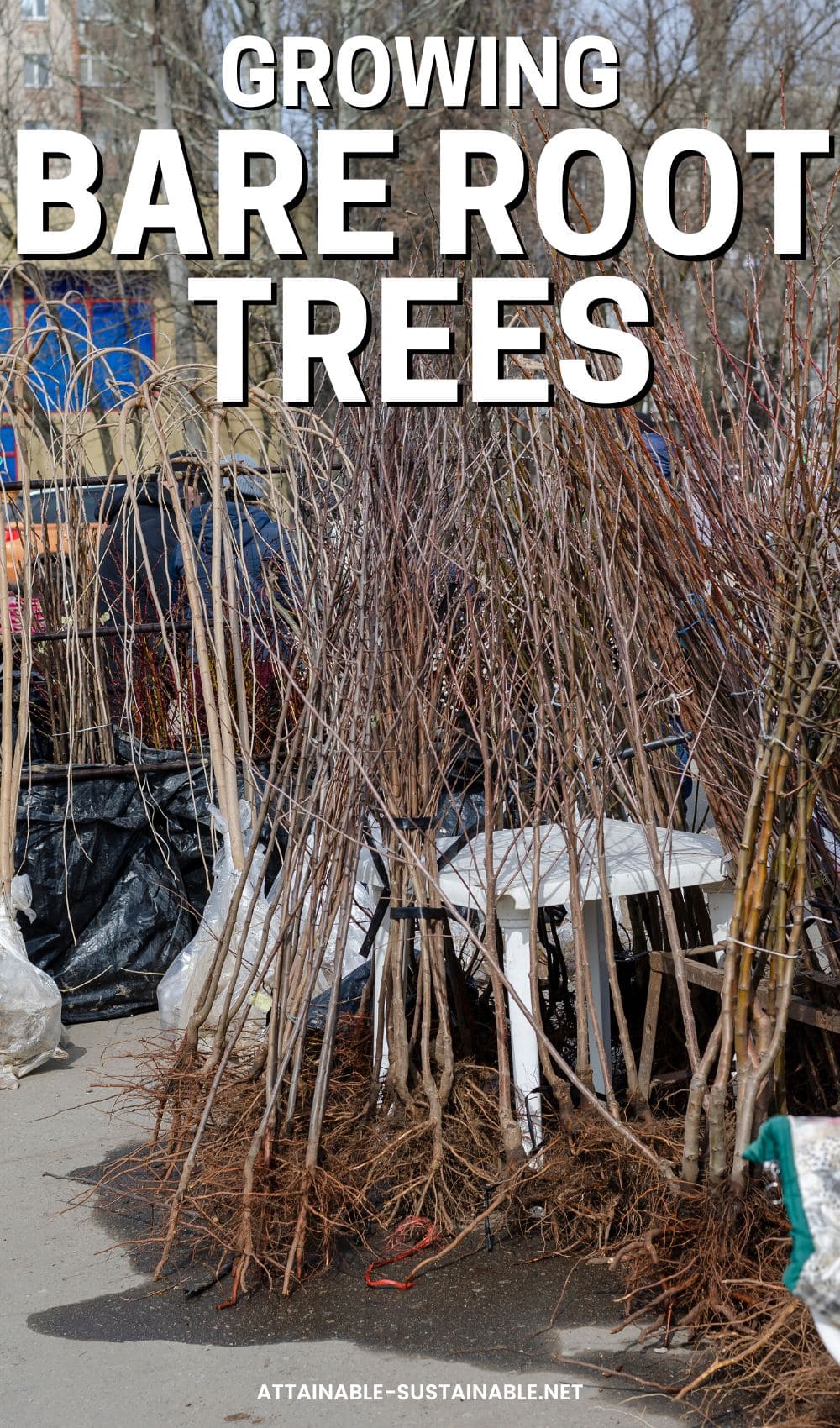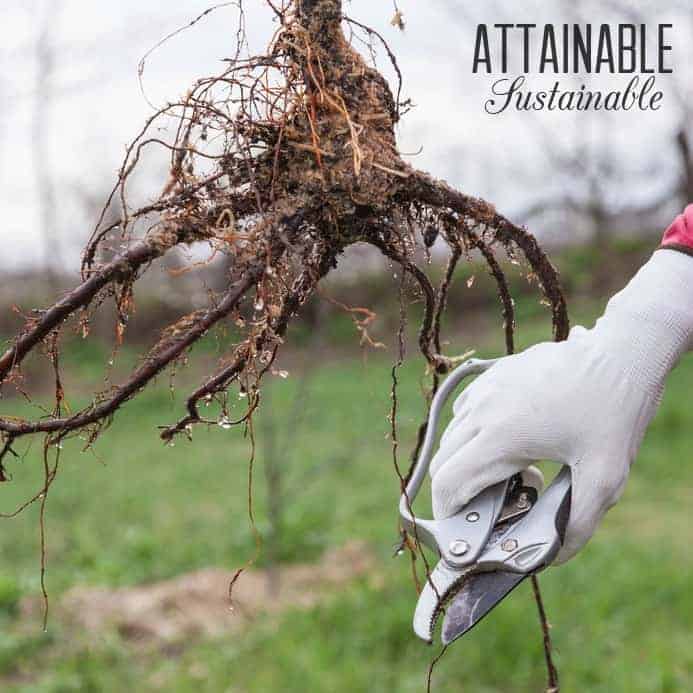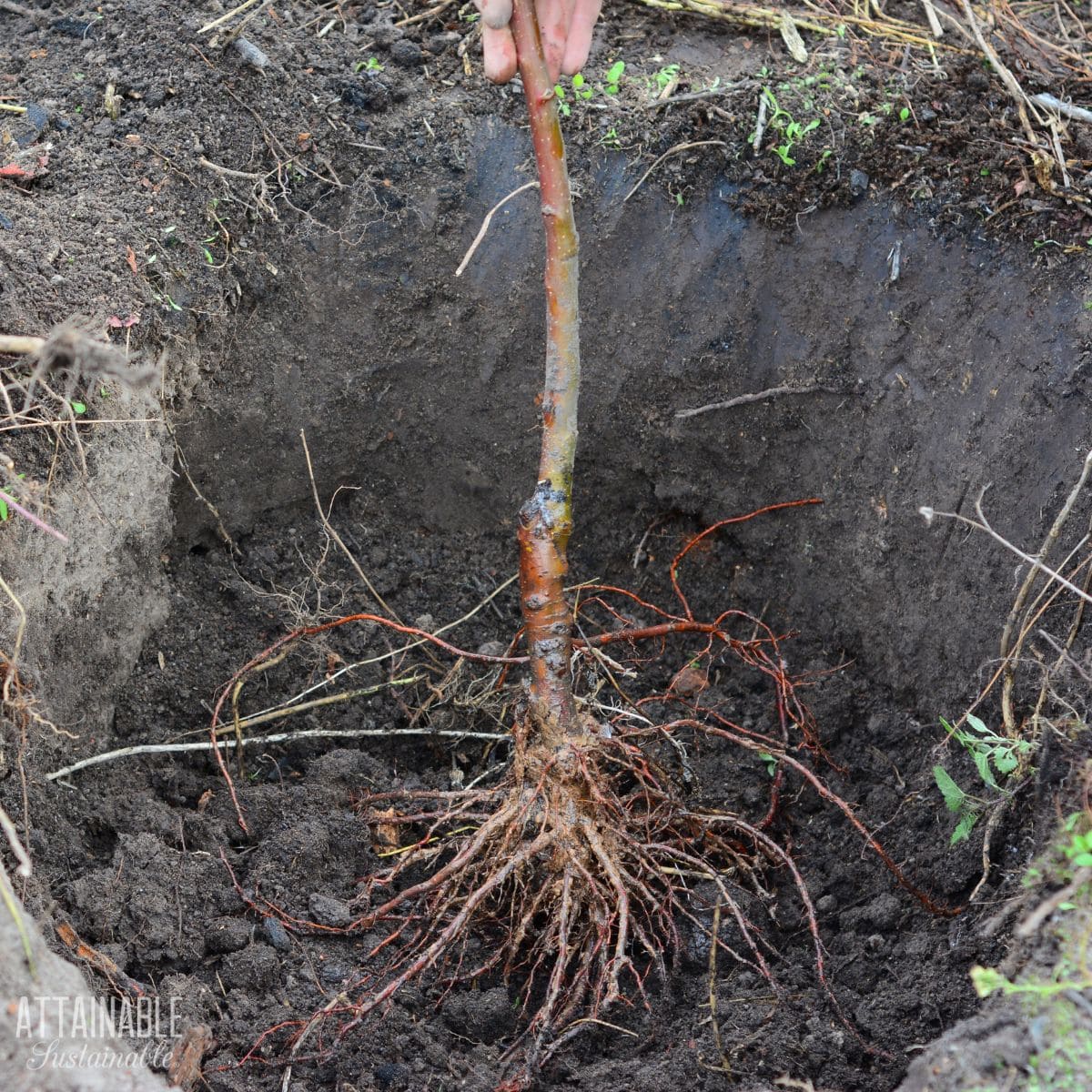A bare root plant comes just like it sounds – with its roots bare, rather than planted in a pot full of soil. Bare root fruit trees and shrubs are available during the late winter, when the plant is dormant and has no leaves. This is a great time to start or expand your home orchard.
Originally published March 2011; this post has been updated.
Why Bare Root Fruit Trees?
Generally speaking, purchasing bare root plants offers a larger selection for buyers. The potted fruit trees and berries you’ll find at nurseries later in the year are often the varieties that didn’t sell during bare root season. There are a number of other reasons to purchase trees and berries in bare root form.
- Buying bare root trees and berries eliminates the need for a plastic pot.
- Bare root trees cost less to produce (no pot, no soil, less labor) so they’re less expensive for the consumer.
- Most retail nurseries purchase their bare root stock from large wholesale nurseries; without the pot and soil, lighter and less cumbersome bare root plants offer a more energy efficient option when it comes to shipping. Of course, if you can find locally grown and grafted fruit trees, better yet.
- Bare root plants are easier for gardeners to manage, too. They’ll often fit in the trunk of a car, and it doesn’t take a circus strongman to heave them around.
There are some disadvantages to bare root plants, too. Without soil, the roots tend to dry out very quickly and need to be protected.
Bare root has a limited window of availability, in part because of the plant’s high moisture needs to get established. Planting them in the early spring allows them to get established while rains are still plentiful.
Grow Some Greens!
Ready to grow fresh greens, no matter WHERE you live? Sign up for my
FREE quick-start guide and start growing some of your own food!
What Kind of Trees are Available as Bare Root?
Of course, this will vary by location and retail outlet, but generally speaking these are the options you’ll have to choose from. Bare root plants are also available from online retailers.
- Apple trees
- Crabapple trees
- Peach trees
- Asian Pear trees
- Nectarine trees
- Plum trees
- Pear trees
- Mulberry trees
- Black walnut
- Sugar maple
New to gardening? Limited on space? The 5-Gallon Garden gives you the skills you need to grow food in the space you have. Get started with your garden today!
Choose the Right Trees for Your Home Orchard
- Consider a standard sized fruit tree if you’re looking for a tree that will also provide shade. These trees can reach 20-30′ and are generally grown in commercial orchards, but a standard fruit tree can also be a beautiful focal point in a large yard. (More about using fruit trees as a landscape tree here.)
- Semi-dwarf trees are medium sized and can work in suburban yards.
- City dwellers who have very limited space might consider a dwarf fruit variety planted in a large planter or half-barrel.
Choosing the Variety
Choosing what variety of apple (or pear or peach) you want to grow might be as easy as choosing the same red-striped variety that grows so well at your neighbors place.
If you want to try something new, though, you’ll need to know about chill hours. Basically, fruit trees need cold weather to trigger flowering (and thus fruiting).
Some varieties need more than others. In my not-so-chilly region, I have to seek out fruit trees that are “low chill” varieties. You’ll need to determine how many chill hours (the average number of hours below 45 degrees Fahrenheit) you get each winter.
Once you’ve chosen a variety, you’ll need to find out if it is self-fertile or if it needs a pollinator. I think it’s fair to say that most fruit trees will need a pollinator. This means the bees need to be able to move pollen from one similar tree to another in order to help set fruit.
In an orchard with many fruit trees, it’s easy to be sure this happens. In a smaller yard, you’ll have to consciously make sure you’re providing what Mother Nature needs to do her job.
If your next-door neighbor has an apple tree that blooms on a similar timeline, that can act as a pollinator for yours. But if there aren’t any other apple trees nearby, you’ll need to get two. This doesn’t mean mean you have to get two of the exact same varieties, though. Just be sure to choose two varieties that flower at the same time.
If you need help figuring out what will work best in your region, look up your local cooperative extension office or Master Gardener program.
Related:
- Urban Fruit: Choosing Trees for Edible Landscaping
- Growing Persimmons: The Best Varieties for a Picky Palate’
- Step-by-Step How to Grow Nectarines from Seed
Buying Bare Root Fruit Trees and Plants
Mail order companies and some quasi-nurseries (like those at home improvement stores) usually sell their bare root plants wrapped in burlap or plastic. If you pick up a tree or shrub at your local nursery (not a big box store), you’ll probably choose your plant and pull it from its sawdust covering, take it home, and plant it.
Heeling In
Of course, it doesn’t always work out that smoothly. You might not have the space for your plant ready yet. In that case, you’ll need to heel the tree in. This is essentially a temporary planting technique that will protect the plant and its roots until you’re ready to put it in its permanent spot in your yard or home orchard.
To do this, dig a hole (or a trench, if you have several trees) that allows you to lay the tree or shrub down at a 45-degree angle, with its roots in the hole.
Cover the roots with loose soil, compost, or sawdust. You’ll want to be sure to set the plant in its permanent home before the tree starts leafing out. The earth will not come to a screeching halt if you don’t, but it’s definitely easier on the tree.
Planting
- Untangle roots and prune any that are broken or damaged.
- Soak the roots in a bucket of water overnight.
- Dig a hole two times the width and depth of the root system you are working with.
- Set the roots on the bottom of the hole so that the graft union is about 4-5″ above ground level. You may need to adjust the bottom of your hole.
- Fan the roots out within the hole. It can help to create a slight hill inside the hole, so that the roots can angle down.
- Fill the hole with good quality soil, slightly compacting it around the roots.
- Water deeply, and then water two or three times per week during the dry season until the tree is established.
- Spread a ring of mulch 2″ deep around the tree to help retain moisture. Avoid letting the mulch touch the trunk of the tree.











I need a source that is reliable. Last year I wasted my money on rootless or dried out trees. Thanks for any help.
Stark Bros is usually pretty good for mail order. Getting them at your local nursery allows you to check their moisture level – mine used to keep the bare root trees in moist wood shavings and it worked great.
How many years does it take before a crab apple tree would supply enough apples to do up?
You’re looking at probably 4-5 years. Which is why NOW is a good time to plant!
Do you have any recommendations on places to order from online?
A great post a full of useful information, I think we are losing a lot of the traditional varieties of apple trees which I think is a great shame, planting them ourselves is definitely one way to keep these varieties alive
Thanks for posting. Especially enjoyed the video!
We’re trying to decide if it’s really warm enough to grow good-tasting navel oranges in the Bay Area. Time will tell.
Thank you! I learned something today. Now I can go back to bed.
Leslie, 9:09 a.m.
Leslie, nothing wrong with a tree that comes in soil, and here in Hawaii that’s probably all you’ll get. Hawaii nurseries just don’t offer much in the way of bare root, since bare root trees are those that require a cold dormant season.
I don’t get why the emphasis on bare root. What’s wrong with a tree coming with soil? Please enlighten.
The article lists some reasons:
They are less expensive, since they are easier to transport (lighter and take less space), and there are less materials (soil, pot).
Less materials makes them better for the environment as well (less waste, & less emissions from transport). Since they take up less space, nurseries can carry a better selection. Bare root also gives the buyer the option for mail-ordering, which can provide a better selection.
A book I read recently (Grow a Little Fruit Tree, by Ann Ralph) said that planting a bare root tree can help the tree grow in the soil in your yard–especially if it isn’t perfect loamy soil. If the plant is sitting in nice cushy potting soil, it’s roots aren’t going to want to push past that into less than ideal dirt. But if that’s all there is (and you give it less-frequent, deep watering) the plant is more likely to grow deeper roots. It also recommends improving the soil and feeding the plant by adding a layer of mulch after you plant the tree. I highly recommend this book! It’s easy to read, and she teaches how to prune the tree to keep it manageable for a home garden. (The book is only about $10, or I found it at my local library.)